
Welcome to lansingsnakes.com! I am David, a snake enthusiast living in Lansing, MI. Many people don't know that Lansing is in fact full of snakes! You just need to know where to find them - they can often be shy and elusive. Some Michigan snake species are more common outside of the city limits, in different parts of Ingham County MI, but many types of snakes are indeed common in the more urban parts of Lansing. This guide is meant to help educate you about the beautiful snakes of Lansing, and to help you identify the most common snakes of Lansing, as well as the venomous snakes of Lansing that you should learn to recognize and avoid. If you want more detail, click here for my complete list of ALL snake species in Lansing. Remember the following:
- Most snakes of Lansing are harmless and don't want to encounter you
- Venomous snakes exist but are uncommon in Lansing, Michigan
- Snakes eat rats and mice and are a valuable part of the Michigan ecosystem
- Never kill a snake - if you leave a snake alone, it will leave you alone.
Common Snake Species in Lansing
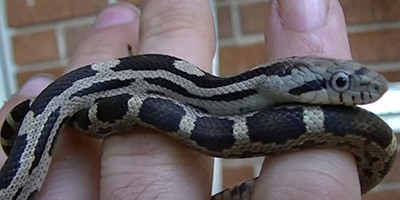 Gray Rat Snake:
This snake is usually a shiny black color with a white chin and throat. Most of the young rat snakes are patterned with dark blotches on a gray background.
The gray rat snake is also considered to be Michigan’s largest snake, growing up to 8 ft. long.
While these snakes are found in a certain area of the state, they have been quite a rare sight as of recently and are now being protected by state law.
When they get frightened, they assume a “kinked” posture and stay motionless where they stop.
Gray Rat Snake:
This snake is usually a shiny black color with a white chin and throat. Most of the young rat snakes are patterned with dark blotches on a gray background.
The gray rat snake is also considered to be Michigan’s largest snake, growing up to 8 ft. long.
While these snakes are found in a certain area of the state, they have been quite a rare sight as of recently and are now being protected by state law.
When they get frightened, they assume a “kinked” posture and stay motionless where they stop.
 Blue Racer:
The blue racer comes in the color gray or blue with smooth scales. Usually, their heads are darker than their body. Their chin and throat are often white, while their belly is light blue to whitish.
These snakes prefer to be in open habitats with abundant cover. Sometimes, they would also live in pastures or abandoned farm fields allowing them to hunt for their primary food source -rodents.
The biggest threat to these snakes is habitat loss as well as human persecution despite being a non-venomous species.
Blue Racer:
The blue racer comes in the color gray or blue with smooth scales. Usually, their heads are darker than their body. Their chin and throat are often white, while their belly is light blue to whitish.
These snakes prefer to be in open habitats with abundant cover. Sometimes, they would also live in pastures or abandoned farm fields allowing them to hunt for their primary food source -rodents.
The biggest threat to these snakes is habitat loss as well as human persecution despite being a non-venomous species.
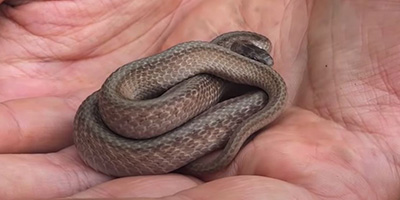 Brown Snake:
Colored in either brown or gray with a light stripe running down the back bordered with black dots, the brown snake is a common site of the rather smaller snakes in the area.
Their belly is white, cream, or a pinkish color and they usually reach a length of up to 15 inches.
Brown snakes are non-venomous, but they also rarely bite. Most of the time, they will be under objects or found below the ground due to their shy nature.
Brown Snake:
Colored in either brown or gray with a light stripe running down the back bordered with black dots, the brown snake is a common site of the rather smaller snakes in the area.
Their belly is white, cream, or a pinkish color and they usually reach a length of up to 15 inches.
Brown snakes are non-venomous, but they also rarely bite. Most of the time, they will be under objects or found below the ground due to their shy nature.
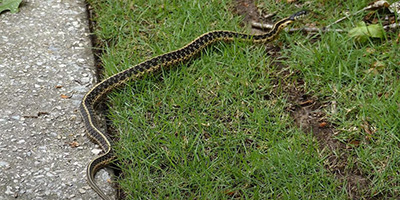 Eastern Garter Snake:
The eastern garter snake is one of the most common snake species found throughout Michigan, inhabiting both peninsulas and urban areas.
They are medium in size with three stripes down the back, usually in the color yellow. Their ground color is mostly gray, brown, or greenish while their belly is pale white, green, or yellow.
These snakes can bite when they are harmed or threatened. However, they are non-venomous. Their tongues are also quite unique, being red with a black tip.
Eastern Garter Snake:
The eastern garter snake is one of the most common snake species found throughout Michigan, inhabiting both peninsulas and urban areas.
They are medium in size with three stripes down the back, usually in the color yellow. Their ground color is mostly gray, brown, or greenish while their belly is pale white, green, or yellow.
These snakes can bite when they are harmed or threatened. However, they are non-venomous. Their tongues are also quite unique, being red with a black tip.
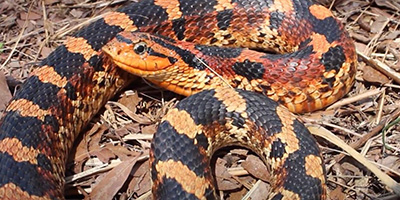 Eastern Hognose Snake:
A distinct characteristic of the hognose snake is its flattened, upturned snout. This is a feature they have that helps people tell them apart from other snakes.
They vary in color but have dark spots and blotches on their body. However, the pattern will sometimes be a little visible or almost invisible.
When threatened, they tend to imitate the movements of a rattlesnake by rapidly shaking their tail -which shows that they have defensive behavior.
Due to the way they act when needing to defend themselves, it causes people to mistake them for the venomous and more dangerous rattlesnakes leading to persecution by humans.
Eastern Hognose Snake:
A distinct characteristic of the hognose snake is its flattened, upturned snout. This is a feature they have that helps people tell them apart from other snakes.
They vary in color but have dark spots and blotches on their body. However, the pattern will sometimes be a little visible or almost invisible.
When threatened, they tend to imitate the movements of a rattlesnake by rapidly shaking their tail -which shows that they have defensive behavior.
Due to the way they act when needing to defend themselves, it causes people to mistake them for the venomous and more dangerous rattlesnakes leading to persecution by humans.
Venomous Snake Species in Lansing
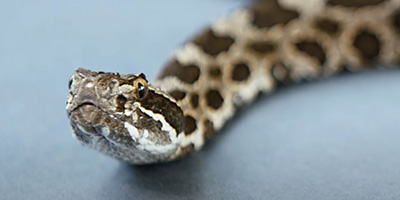 Eastern Massasauga Rattlesnake:
In all of Michigan, there is only one venomous snake variant known as the eastern massasauga rattlesnake -which is also said to be quite a rare sight to people of the area.
They tend to be in wetlands or upland woods during the spring and move to drier areas in the summer season.
Although these snakes are dangerous, they avoid confrontation with predators around them. Unless they are intentionally provoked or harmed, they normally won’t bite.
The eastern massasauga rattlesnake is also known to be the smallest rattlesnake in the country and has the least-toxic venom among other venomous species.
Eastern Massasauga Rattlesnake:
In all of Michigan, there is only one venomous snake variant known as the eastern massasauga rattlesnake -which is also said to be quite a rare sight to people of the area.
They tend to be in wetlands or upland woods during the spring and move to drier areas in the summer season.
Although these snakes are dangerous, they avoid confrontation with predators around them. Unless they are intentionally provoked or harmed, they normally won’t bite.
The eastern massasauga rattlesnake is also known to be the smallest rattlesnake in the country and has the least-toxic venom among other venomous species.
If you're unsure, you can email me a photo of the snake at info@lansingsnakes.com and I will email you back with the snake's species. If you found a snake skin, read my Found a Skin? page, and you can email me a photo of the skin, and I'll identify the snake for you. If you need professional Lansing snake removal help, click my Get Help page, or see the below website sponsor I found, who provides that service.
Remember, the term is not poisonous snakes of Lansing, it's venomous snakes of Lansing. Poison is generally something you eat, and venom is injected into you. That said, dangerous snakes are very rare in Lansing. The few venomous snakes of Ingham County are rarely seen. But they are commonly misidentified, so learn about all the snake species of Lansing in order to correctly identify them. These snakes are usually also found in the surrounding towns of Mason, Meridian charter Township, Williamston, Delhi charter Township, Dansville, Stockbridge, Webberville, Leslie, Edgemont Park, and the surrounding areas.
Read our article about:
You May Not Be Aware that You Are Attracting the Attention of Snakes
lansingsnakes.com domain and hosting costs made possible by the generous support of this sponsor:
